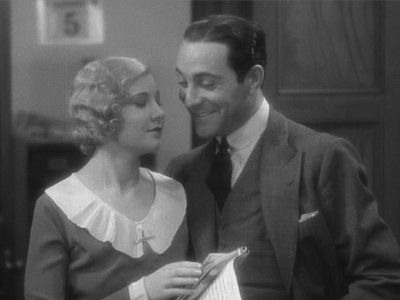When film noir comes up, most people familiar with the term at all will go straight to John Huston's adaptation of Dashiell Hammett's 1930 private detective novel, The Maltese Falcon to establish that familiarity. While Huston's take, released in 1941, is, by far, the best known and, as you'll see, the best made, it was Warner Bros. third bite at Hammett's sour apple.
Released in 1931, before there was really such a thing as film noir and just one year after Hammett's novel, the first FALCON starred top-billed former Radio Pictures musical star Bebe Daniels, as Ruth Wonderly and faux Latin lover Ricardo Cortez as this version's Sam Spade.
The cast dutifly follows Maude Fulton, Brown Holmes, and an uncredited Lucien Hubbard's script, which hues close to Hammett's novel but diverges just enough to dull most of its edge. Director Roy Del Ruth keeps things moving at a decent clip, but I did find myself zoning in and out a few times over the film's 80-minute running time. I might be tempted to put that down to my familiarity with the story and script, indeed both the '31 and '41 versions lift much dialog directly from Hammett's text, but that's not the case as I'm riveted every time I sit down for Huston's film.
I think my detachment from the original FALCON has all to do with the character interpretations; they're just not that good, overall. Cortez's Sam Spade is a grinning, incorrigible skirt-chaser. His affair with Miles Archer's wife, played here by Thelma Todd, who, I have to say, sexys Gladys George under the table, is just one in a series. In fact, Spade kicks his latest conquest out of his office, hits on gal Friday Effie Perine, and takes a yearning phone call from Iva within the first five minutes of the film. In general, this Sam Spade has altogether too much fun chasing after The Black Bird, and that didn't sit well with me. I much prefer Bogart's Spade, who was ambiguous to the brink of villainy and discontented pretty much the whole way through, taking only momentary pleasure from picking on Wilmer or mustering false bluster for The Fat Man.
The rest of the cast pale in comparison to their '41 counterparts. Dudley Digges has some of Sydney Greenstreet's eccentricity, but none of his gravitas. I love, love, love me some Dwight Frye, the '31 Wilmer, but he's given next to nothing to do. Elisha Cook's Wilmer was all frustrated, soft around the edges, kept boy rage. Worst of all is Otto Matieson's Doctor, for some reason, Cairo. His opening scene in Spade's office is scripted almost exactly the same in the '31 and '41 versions, but Matieson doesn't lay a perfumed glove on the nuance Peter Lorre brought to his every line and look.
The one cast standout in the '31 version is Bebe Daniels, who earned her top billing. I didn't like the sort of fun, flirty almost an actual relationship she had with Spade, and I didn't like that her name actually was Wonderly, but I at least understood why Cortez would fall for her. I like Mary Astor as much as the next guy, but I've never really thought Bogart's Spade actually loved her. I've never bought that aspect of the Huston version; I've always thought that Sam Spade strung Bridgid along to find out who killed Miles Archer, nothing more. Daniels's performance allows for the possibility both things are true, particularly after the script tacks on a needless, emasculating coda with Spade visiting Wonderly in jail. In any event, Bebe Daniels was my favorite part of the original FALCON.
The sexual candor wasn't bad, either. Made after the institution of the Motion Picture Production Code but before it was really enforced, the 1931 MALTESE FALCON features much closer caressing, and a lot more of it, with fewer clothes, than the Huston film, released well into Hollywood's best behavior period. I had to laugh at Sam Spade straightening up his disheveled office after showing the opening scene floozy the door. I know what they were doing in there.
Cheeky pre-code Hollywood.
Saying that, though, I was surprised by now much the homosexuality is muted in the '31 FALCON. It's right on the page in Hammett's book, and even the '41 film has overtones galore if you're paying attention, but, aside from a line or two, there was nothing overt in the '31 version. I expected more.
1931's THE MALTESE FALCON is worth seeing, but it won't rival, or make you forget a moment of, the Huston classic. Watching it, I never got the sense anyone really cared all that much about The Black Bird. Indeed, when the statue is revealed to be a fake, everyone's attitude seemed to be meh, alright then, on to the next thing. That's pretty much how I felt about the film. Fun little ride, but not the stuff dreams are made of.
-J
Follow @JasonChirevas



No comments:
Post a Comment